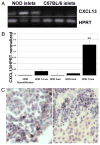CXCL13 blockade disrupts B lymphocyte organization in tertiary lymphoid structures without altering B cell receptor bias or preventing diabetes in nonobese diabetic mice
- PMID: 20574003
- PMCID: PMC3824617
- DOI: 10.4049/jimmunol.0903710
CXCL13 blockade disrupts B lymphocyte organization in tertiary lymphoid structures without altering B cell receptor bias or preventing diabetes in nonobese diabetic mice
Abstract
Lymphocytes that invade nonlymphoid tissues often organize into follicle-like structures known as tertiary lymphoid organs (TLOs). These structures resemble those found in spleen or lymph nodes, but their function is unknown. TLOs are recognized in many autoimmune diseases, including the NOD mouse model of type 1 diabetes. In some cases, TLOs have been associated with the B lymphocyte chemoattractant, CXCL13. Studies presented in this article show that CXCL13 is present in inflamed islets of NOD mice. Ab blockade of this chemokine unraveled B lymphocyte organization in islet TLOs, without reducing their proportion in the islets. These chaotic milieus contained B lymphocytes with the same distinct repertoire of B cell receptors as those found in mice with well-organized structures. Somatic hypermutation, associated with T-B interactions, was not impaired in these disorganized insulitis lesions. Finally, loss of B lymphocyte organization in islets did not provide disease protection. Thus, B lymphocytes infiltrating islets in NOD mice do not require the morphology of secondary lymphoid tissues to support their role in disease.
Conflict of interest statement
The authors have no financial conflicts of interest.
Figures






Similar articles
-
Evolution of ectopic lymphoid neogenesis and in situ autoantibody production in autoimmune nonobese diabetic mice: cellular and molecular characterization of tertiary lymphoid structures in pancreatic islets.J Immunol. 2010 Sep 15;185(6):3359-68. doi: 10.4049/jimmunol.1001836. Epub 2010 Aug 16. J Immunol. 2010. PMID: 20713891
-
Dysregulated B7-1 and B7-2 expression on nonobese diabetic mouse B cells is associated with increased T cell costimulation and the development of insulitis.J Immunol. 2005 Jan 15;174(2):680-7. doi: 10.4049/jimmunol.174.2.680. J Immunol. 2005. PMID: 15634886
-
Identification and characterisation of tertiary lymphoid organs in human type 1 diabetes.Diabetologia. 2021 Jul;64(7):1626-1641. doi: 10.1007/s00125-021-05453-z. Epub 2021 Apr 29. Diabetologia. 2021. PMID: 33912981 Free PMC article.
-
Effects of CXCL13 inhibition on lymphoid follicles in models of autoimmune disease.Eur J Clin Invest. 2013 May;43(5):501-9. doi: 10.1111/eci.12063. Epub 2013 Mar 20. Eur J Clin Invest. 2013. PMID: 23517338 Review.
-
Cellular and molecular pathogenic mechanisms of insulin-dependent diabetes mellitus.Ann N Y Acad Sci. 2001 Apr;928:200-11. doi: 10.1111/j.1749-6632.2001.tb05650.x. Ann N Y Acad Sci. 2001. PMID: 11795511 Review.
Cited by
-
Role of tertiary lymphoid structures and B cells in clinical immunotherapy of gastric cancer.Front Immunol. 2025 Jan 7;15:1519034. doi: 10.3389/fimmu.2024.1519034. eCollection 2024. Front Immunol. 2025. PMID: 39840050 Free PMC article. Review.
-
T-B Lymphocyte Interactions Promote Type 1 Diabetes Independently of SLAM-Associated Protein.J Immunol. 2020 Dec 15;205(12):3263-3276. doi: 10.4049/jimmunol.1900464. Epub 2020 Nov 16. J Immunol. 2020. PMID: 33199538 Free PMC article.
-
Control of CD8 T-Cell Infiltration into Tumors by Vasculature and Microenvironment.Adv Cancer Res. 2015;128:263-307. doi: 10.1016/bs.acr.2015.05.001. Epub 2015 Jun 1. Adv Cancer Res. 2015. PMID: 26216636 Free PMC article. Review.
-
T cell-driven initiation and propagation of autoimmune diabetes.Curr Opin Immunol. 2011 Dec;23(6):754-60. doi: 10.1016/j.coi.2011.10.002. Epub 2011 Nov 4. Curr Opin Immunol. 2011. PMID: 22056379 Free PMC article. Review.
-
A novel approach to improve immune effector responses post transplant by restoration of CCL21 expression.PLoS One. 2018 Apr 4;13(4):e0193461. doi: 10.1371/journal.pone.0193461. eCollection 2018. PLoS One. 2018. PMID: 29617362 Free PMC article.
References
-
- Aloisi F, Pujol-Borrell R. Lymphoid neogenesis in chronic inflammatory diseases. Nat Rev Immunol. 2006;6:205–217. - PubMed
-
- Manzo A, Vitolo B, Humby F, Caporali R, Jarrossay D, Dell’accio F, Ciardelli L, Uguccioni M, Montecucco C, Pitzalis C. Mature antigen-experienced T helper cells synthesize and secrete the B cell chemoattractant CXCL13 in the inflammatory environment of the rheumatoid joint. Arthritis Rheum. 2008;58:3377–3387. - PubMed
-
- Bagaeva LV, Rao P, Powers JM, Segal BM. CXC chemokine ligand 13 plays a role in experimental autoimmune encephalomyelitis. J Immunol. 2006;176:7676–7685. - PubMed
-
- Manzo A, Paoletti S, Carulli M, Blades MC, Barone F, Yanni G, Fitzgerald O, Bresnihan B, Caporali R, Montecucco C, et al. Systematic microanatomical analysis of CXCL13 and CCL21 in situ production and progressive lymphoid organization in rheumatoid synovitis. Eur J Immunol. 2005;35:1347–1359. - PubMed
-
- Takemura S, Braun A, Crowson C, Kurtin PJ, Cofield RH, O’Fallon WM, Goronzy JJ, Weyand CM. Lymphoid neogenesis in rheumatoid synovitis. J Immunol. 2001;167:1072–1080. - PubMed
Publication types
MeSH terms
Substances
Grants and funding
- P60 DK020593/DK/NIDDK NIH HHS/United States
- HL65962/HL/NHLBI NIH HHS/United States
- P30 DK058404/DK/NIDDK NIH HHS/United States
- U01 HL065962/HL/NHLBI NIH HHS/United States
- P30 DK020593/DK/NIDDK NIH HHS/United States
- T32 HL069765/HL/NHLBI NIH HHS/United States
- P30 CA068485/CA/NCI NIH HHS/United States
- L40 AI057271/AI/NIAID NIH HHS/United States
- CA68485/CA/NCI NIH HHS/United States
- DK058404/DK/NIDDK NIH HHS/United States
- P30 CA68485/CA/NCI NIH HHS/United States
- U19 HL065962/HL/NHLBI NIH HHS/United States
- DK20593/DK/NIDDK NIH HHS/United States
- K08 DK070924/DK/NIDDK NIH HHS/United States
LinkOut - more resources
Full Text Sources
Medical

